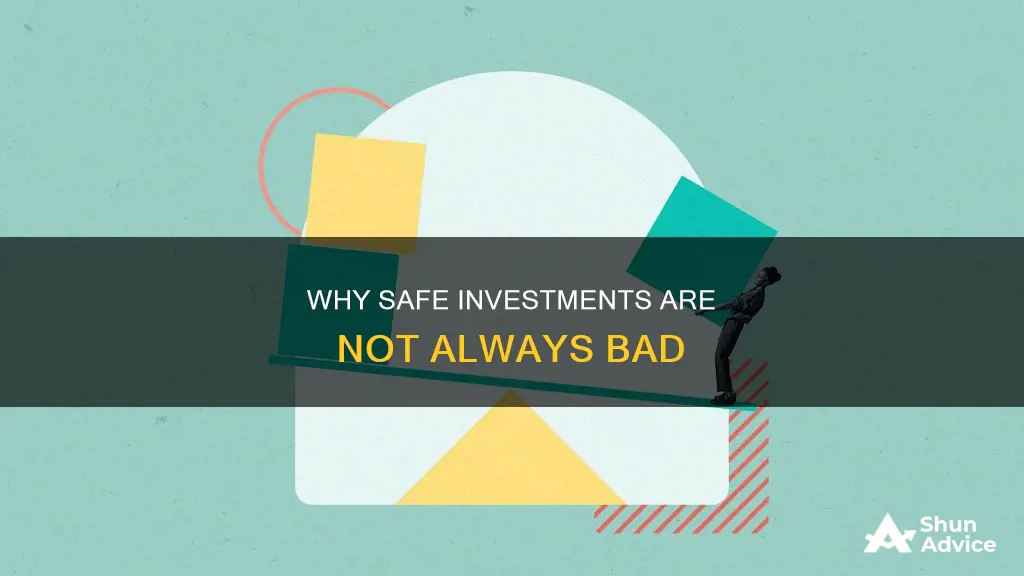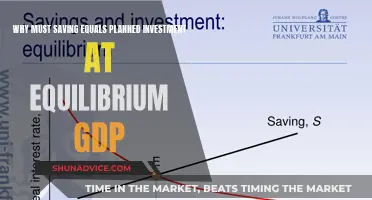
High-risk investments are those that carry a large percentage chance of loss of capital or underperformance, or a relatively high chance of a devastating loss. They are often advertised as high-return investments, but there is no guarantee that they will deliver high returns. In fact, the actual returns could be lower than those of mainstream investments. The higher the return promised, the higher the risk.
Some examples of high-risk investments include:
- Initial Public Offerings (IPOs)
- Real Estate Investment Trusts (REITs)
- Venture Capital
- Cryptoassets (cryptocurrencies)
- Mini-bonds (high-interest return bonds)
- Contracts for Difference (CFDs)
- Land banking
- Spread betting
| Characteristics | Values |
|---|---|
| Returns | Smaller |
| Loss of money | Unlikely |
| Predictability | High |
| Peace of mind | High |
| Portfolio balance | High |
| Protection against market volatility | High |
| Wealth growth | Slower |
| Keeping pace with inflation | Slower |
| Acceleration of wealth | Low |
| Uncertainty | Low |
What You'll Learn

Money market accounts
MMAs are generally considered safe, low-risk investments. Here are some reasons why:
Federal Insurance
MMAs are insured by the Federal Deposit Insurance Corporation (FDIC) for up to $250,000 per depositor. This means that if the bank or institution fails, your investments will be covered up to the insured amount.
Low-Risk Investments
Banks use the funds from MMAs to invest in stable, short-term, low-risk securities that are highly liquid. These include certificates of deposit (CDs), government securities, and commercial paper. Once these investments mature, the bank splits the return with you, resulting in a higher interest rate for your MMA.
Low Volatility
Money market funds are considered one of the least volatile types of investments available. This means that even in a volatile market, your investment remains relatively stable and secure.
Diversification
Money market funds offer instant diversification across a range of securities. This diversification is an important safeguard for your portfolio, reducing the overall risk.
Liquidity
Money market funds primarily invest in highly liquid, in-demand securities such as Treasury bills and short-term bonds. This means that investors can buy and sell them with relative ease.
While money market accounts are generally safe and low-risk, there are still some small risks and potential downsides to consider:
Inflation Risk
One of the biggest risks associated with MMAs is the possibility that inflation will outpace the interest rate earned, causing your money to lose spending power over time.
Fees
Variable Interest Rates
MMA interest rates can change after you've opened an account. There is no guarantee that a competitive rate will remain competitive.
Minimum Balance Requirements
Transaction Limits
MMAs may have monthly withdrawal limits, typically allowing only six free withdrawals each month before charging an excess withdrawal fee.
Inventories Management and Inter-corporate Investments: Strategies for Success
You may want to see also

Government bonds
When you buy a government bond, you are essentially loaning money to the government, which will repay you with interest over time. The interest is paid at a fixed rate every six months until the bond matures. Treasury bonds are considered safer than corporate bonds because there is almost no chance that the investor will not receive the stated interest and principal payments. The US government has an excellent track record of repaying its debts, and even in the rare case of delayed payments, investors have recouped a large portion of their investment.
While government bonds are a low-risk investment, there are still some potential risks to consider:
- Opportunity Risk: There is a possibility that you could have earned better returns by investing elsewhere. The low yield of T-bonds can be eroded by inflation, resulting in a loss of savings.
- Interest Rate Risk: When interest rates rise, the market value of debt securities tends to drop, making it challenging for bond investors to sell T-bonds without incurring losses.
- Inflation Risk: Inflation can diminish the returns on government bonds over time, especially for long-term bonds.
- Diversification: Holding only low-risk investments like Treasury bonds can be dangerous as they are all exposed to the same risks. Diversifying your portfolio with short-term bonds, equities, and other asset classes is essential to balance risk and return.
In summary, government bonds are considered a safe, low-risk investment option due to the strong creditworthiness of the US government. However, investors should be aware of the potential risks and consider diversifying their portfolios to balance risk and maximize returns.
Investing vs Saving: Understanding the Key Differences
You may want to see also

High-yield savings accounts
The best high-yield savings accounts have strong interest rates, good perks, and national accessibility. They also have no monthly maintenance fees and low minimum opening deposits.
- DCU Primary Savings Account: 0.05% to 6.17% APY
- Varo Savings Account: 2.50% to 5.00% APY
- Axos ONE Savings and Checking Bundle: up to 4.86% APY
- Openbank High Yield Savings: 4.75% APY
- Pibank Savings: 4.60% APY
- Newtek Bank Personal High Yield Savings Account: 4.55% APY
- BrioDirect High-Yield Savings Account: 4.55% APY
- Jenius Savings Account: 4.50% APY
- LendingClub LevelUp Savings Account: up to 4.50% APY
As with any investment, there are some risks to consider. Savings accounts have a variable interest rate, which means it can fluctuate. There may also be transfer limits, and some banks restrict withdrawals/transfers to only six per month. It's also worth noting that checks generally can't be written using savings accounts.
However, overall, high-yield savings accounts are a good low-risk option for anyone who wants to grow their money without taking on too much risk.
Investments: Assets or Equity? Understanding the Basics of Finance
You may want to see also

Cash management accounts
A cash management account (CMA) is an alternative to a traditional bank account, offering a secure place to store your money while also providing a competitive annual percentage yield (APY) and similar features to traditional bank accounts. They are typically offered by brokerage firms and investment banks, and can be used to hold cash, invest in securities, and make payments.
CMA providers partner with banks and sweep customer deposits into partner bank accounts, where the funds benefit from the bank's Federal Deposit Insurance Corporation (FDIC) insurance. This means that even if the brokerage were to fail, your money is protected. However, it may take longer to retrieve your money in this scenario.
CMAs tend to offer much higher FDIC insurance limits than traditional banks, with some offering up to $8 million for individual accounts. They also usually pay interest, with rates much higher than the national average savings account APY.
Some features of cash management accounts include:
- Competitive interest rates
- Low or no fees
- Direct deposit
- Bill payments
- Debit card
- Check writing
- Unlimited ATM fee reimbursement
- Mobile app
- Budgeting features
- Compatibility with digital wallets and payment apps
Some popular cash management accounts include:
- Wealthfront Cash Account
- Betterment Cash Reserve
- Empower Personal Cash
- Vanguard Cash Plus Account
- Fidelity Cash Management Account
Is Peer-to-Peer Investing a Smart Move?
You may want to see also

Treasury bills
T-bills are considered a low-risk investment because there is almost no chance that an investor will fail to receive the stated interest and principal payments. Even if there were delays in payment (which is extremely rare in the history of the US), investors would likely recoup a large portion of the investment. The US government has never defaulted on a debt or missed a payment, so you would have to envision the collapse of the government to lose any of the principal invested in a T-bill.
However, it is important to note that there is a risk of opportunity cost with T-bills. The crucial word above is "principal". In investing, the safest investments often have the lowest returns. As a result, accepting a low return is a risky decision in itself, as investors might have gotten a better return elsewhere. For example, T-bills have a low yield or return on investment, and even a small amount of inflation can effectively eat into your savings.
Additionally, when interest rates rise, the market value of debt securities tends to drop, making it difficult for investors to sell T-bills without losing money on their investment. Therefore, while T-bills are considered low-risk, there are still some factors that investors should consider before investing.
African Equities: A Guide to Investing in the Continent's Future
You may want to see also
Frequently asked questions
Low-risk investments are those that have a certain amount of consistency and are less likely to result in financial losses. While they may not offer the potential for large financial returns, they can provide peace of mind and help balance your investment portfolio. Examples include bonds, high-yield savings accounts, money market accounts, and certificates of deposit (CDs).
Low-risk investments are considered safer bets, while high-risk investments offer the potential for larger financial gains but also carry a greater chance of financial loss.
Low-risk investments provide more predictability and stability, which can be reassuring for investors who are averse to market volatility. They can also help diversify your investment portfolio and protect against potential losses.
Bonds, particularly those offered by government agencies or municipalities, are considered low-risk as they provide a steady stream of interest payments. High-yield savings accounts and money market accounts offer higher interest rates than traditional savings accounts while still providing easy access to your money. Certificates of Deposit (CDs) offer a fixed rate of return but require you to keep your money invested for a specified period.
The decision to invest in low-risk or high-risk investments depends on your financial goals, risk tolerance, and investment horizon. Low-risk investments are generally suitable for those who prioritize capital preservation and stable returns over high growth potential. They can also help balance out higher-risk investments in your portfolio.







